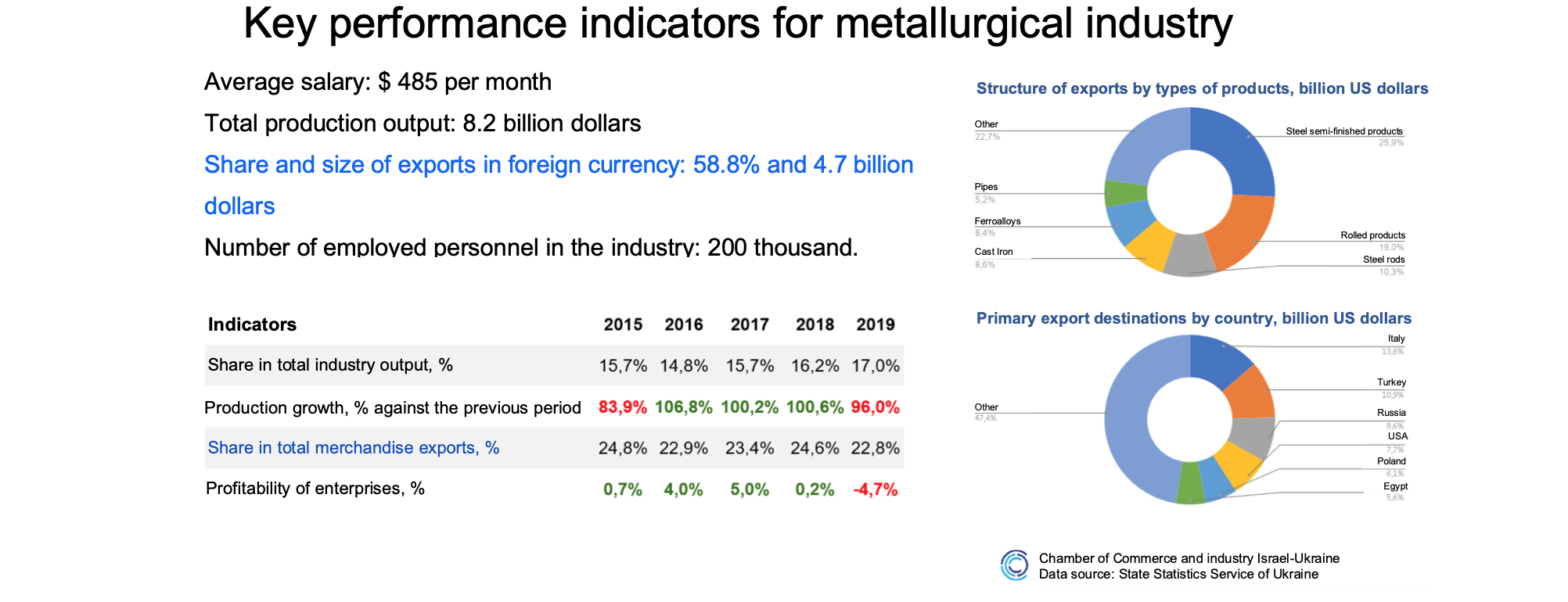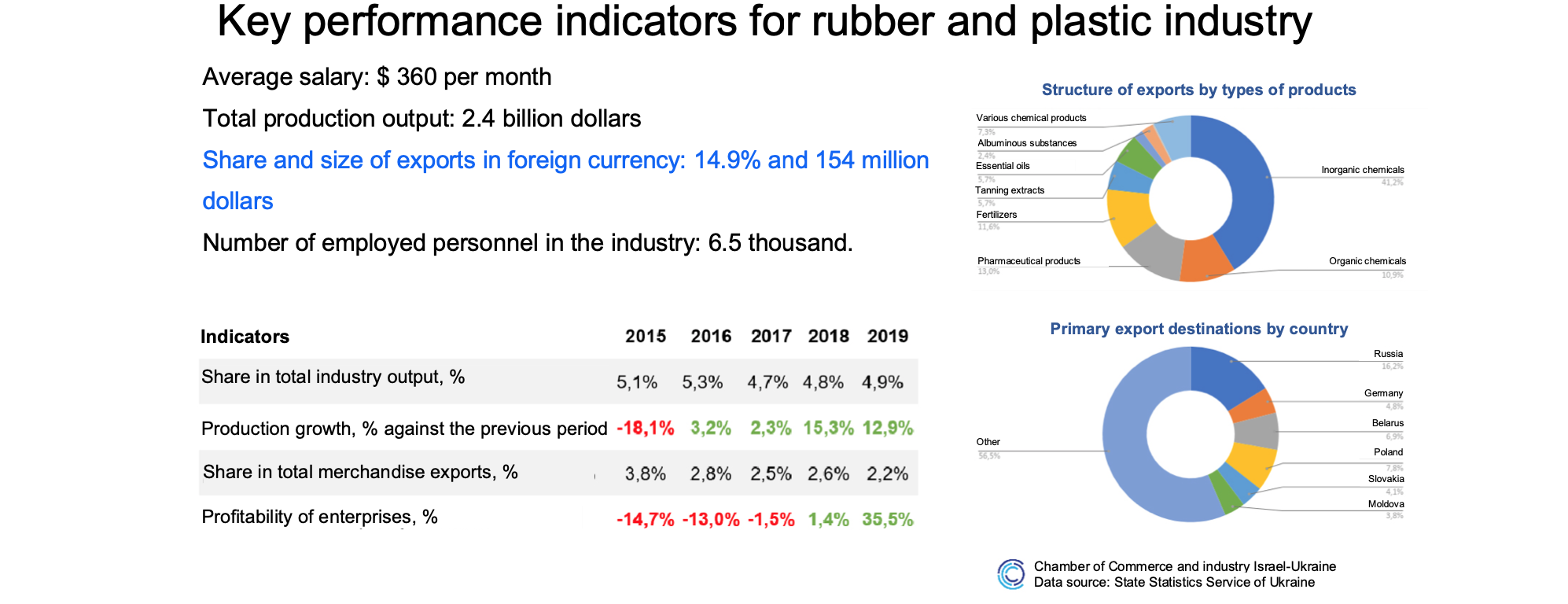Industrial capacities of Ukraine: directions, current state, export potential
 Indicators of Ukraine’s export potential. Sources: Readiness for the Future of Production Report 2018 and Ukraine. Time to invest (Davos2020)
Indicators of Ukraine’s export potential. Sources: Readiness for the Future of Production Report 2018 and Ukraine. Time to invest (Davos2020)
Ukraine’s industry ranks 60th in terms of production among all countries of the world: 22 billion dollars or 0.15% of the world’s industry. Most of the country’s economy involves agribusiness, mining, as well as food, light, chemical and metallurgical industries. About 30% of the produced products are exported. The technological base is largely obsolete and requires modernization. This determines the necessity for collaboration with international partners in the implementation of technologies related to Industry 4.0.
In this article we will take a look at five branches of industry in Ukraine, analyzing the following points:
- Export structure, volume, and directions.
- Current status: salaries, profitability, production volumes.
- Prospects for start-up of new export-oriented enterprises in Ukraine
Metallurgy. Manufacturing of finished metal product
 Metallurgical industry of Ukraine: key facts, structure and export directions. Source: State Statistics Service of Ukraine
Metallurgical industry of Ukraine: key facts, structure and export directions. Source: State Statistics Service of Ukraine
Current state. The metallurgical industry in Ukraine provides up to 17% of the total volume of industrial products sold, a fifth of merchandise exports and 4.7 billion dollars of export revenue, 200 thousand jobs and about 10% of the total average number of full-time employees in the industry.
Almost all production is accounted for by large enterprises such as: “Azovstal Iron and Steel Works”, “Dniprospetsstal”, “Donetsk Iron and Steel Works”, “Zaporizhstal”, “ArcelorMittal” and “Dniprovskyi Iron and Steel Works”. Together, they produce 25.5 million tons of cast iron, 21.1 million tons of steel, 11.3 million tons of rolled products and 1.1 million tons of pipes, tubes and hollow profiles made of steel.
Advantages οf Ukraine. Ukraine as a platform for starting-up metallurgical enterprises in comparison with other countries has following competitive advantages:
- Proximity to importing countries: Europe and the European part of the Russian Federation – share borders, Turkey – 620 km along the Black Sea, and Ashdod – 2,500 km by sea.
- Lower average salary in the industry: $ 485 per month compared to $ 920 in China, $ 1,250 in Poland, and $ 690 in Russia.
- Free trade zone with the EU countries, Canada, Israel and Turkey.
- Accessibility and ease of connection to the power grid (many factories in the country have closed, but communications remain).
- Proximity to raw material sources.
One more non-obvious advantage of Ukraine is the obsolete technological base (the share of outmoded equipment is 50-70%). If you start a new production with modern equipment, you can get a local advantage over existing enterprises in Ukraine and the ability to cover part of the domestic and foreign markets.
In addition, Ukraine began to apply the provisions of the pan-Euro-Mediterranean Convention in 2019, which allows, for example, an Israeli manufacturer to purchase raw materials in Ukraine, import them at a reduced or zero duty rate and then sell the finished product to the EU countries, maintaining the status of preferential origin.
Chemical industry
 Chemical industry of Ukraine: key facts, structure and export directions. Source: State Statistics Service of Ukraine
Chemical industry of Ukraine: key facts, structure and export directions. Source: State Statistics Service of Ukraine
Current state. The share of the chemical industry in total production volume of Ukraine is 4-5%, which is significantly lower than in other countries (for comparison, the share of chemical products in developed countries is from 8 to 13%). Reason for the gap:
- conflict in Eastern Ukraine, beginning in 2014, in course of which Ukraine lost control over the part of the territory that contained the country’s raw materials deposits and significant chemical facilities;
- obsolete technology base;
- breaking production chains after the dissolution of the USSR.
As for the structure of production, it is mainly goods with low added value: fertilizers and nitrogen compounds, synthetic rubber and plastic. The fallowing largest enterprises are concentrated in this segment:
- Ostchem Holding Group: PAT “Azot” (Cherkasy), PrAT “Rivnoazot” Rivne), PrAT “Severodonetsk Azot Association” (Severodonetsk). Their share in the production of fertilizers and nitrogen compounds, synthetic rubber and plastic is from 15 to 17% over the years.
- Enterprises of AT “Ukragrohimholding”: PrAT “Dniprovskyi Mineral Fertilizer Plant” ( Kamianske), PrAT “Eco-Azot” (Cherkasy).
- PAT “Odessa Port Plant” (Yuzhne).
- PrAT “Himdivision” (Kamianske).
- AT “DniproAzot”(Kamianske).
- PAT “Sumykhimprom” (Sumy).
These enterprises account for about 22% of total production and 37% of the employed workforce in the chemical industry of Ukraine. Considering the industry as a whole, small businesses account for 16% ($156 million), medium-sized enterprises for 72% ($936 million), and large for 12% ($208 million). This is generally a normal ratio that meets the criteria of a competitive market.
Advantages οf Ukraine. For potential investors considering the possibility of transferring chemical production to Ukraine, the advantages would be:
- Free trade zone with the EU countries, Canada, Israel and Turkey. Participation in the pan-Euro-Mediterranean Convention;
- Proximity to raw material sources and markets;
- Ease of connection to the power grid;
- Low cost labor.
Manufacturing of rubber and plastic products and other non-metallic mineral products
 Rubber and plastic production in Ukraine: key facts, structure and export directions. Source: State Statistics Service of Ukraine
Rubber and plastic production in Ukraine: key facts, structure and export directions. Source: State Statistics Service of Ukraine
Current state. As for the production of rubber products, Ukraine mainly produces tires, pipes, insulation materials, gaskets, hoses, shoes, crumb rubber, tiles, rubber compounds, and so on. Leading enterprises for production of tires: “Dniproshina” in Dnipro and “Rosava” in Bila Tserkva. For example, “Rosava” has capacities to produce more than 6 million tires a year. Industrial rubber goods are manufactured at small and medium-sized enterprises in Lysychansk, Sumy, Zaporizhzhia, Odessa, Kharkiv and Donetsk.
Plastic manufacturing is scattered throughout Ukraine and is mainly focused on packaging goods, accessories, metal-plastic products, parts for various devices and vehicles.
Advantages οf Ukraine.
Primary advantages:
- Free trade zone with the EU countries, Canada, Israel and Turkey. Participation in the pan-Euro-Mediterranean Convention;
- Proximity to plastic importing countries (EU and Russia);
- Almost empty plastic recycling market, i.e. a lot of cheap raw materials;
- Cheap labor.
Manufacturing of computers, electrical and optical goods
 Precision engineering in Ukraine: key facts, export structure. Source: State Statistics Service of Ukraine
Precision engineering in Ukraine: key facts, export structure. Source: State Statistics Service of Ukraine
Current state. This industry is almost undeveloped. There are three reasons: the first is the legacy of the Soviet Union, which relied on heavy engineering, the second is the lack of investment, and the third is the cheap import of computers, phones, cameras, and other gadgets. All that is available in Ukraine in terms of precision engineering is the production of photodiodes, phototransistors, semiconductors, cables, and measuring devices.
Advantages οf Ukraine. Primary advantages:
- Large number of high-level technical personnel who are in demand abroad, but are almost not in demand inside Ukraine;
- Free trade zone with the EU countries, Canada, Israel and Turkey. Participation in the pan-Euro-Mediterranean Convention;
- Cheap labor.
Manufacturing of woodwork products. Paper manufacturing
 Woodworking and paper industry of Ukraine: key facts, structure and export directions. Source: State Statistics Service of Ukraine
Woodworking and paper industry of Ukraine: key facts, structure and export directions. Source: State Statistics Service of Ukraine
Current state. The share of woodworking in the country’s industry is low – from 3 to 4%. This industry does not cover the needs of the domestic market for most types of products. This is mainly due to the limited resource base: low forest cover (forests occupy only 14% of the territory of Ukraine), dominance of forests with limited operational value and low level of logging. The main sources of raw materials cover the needs of the industry only by a third, the rest is imported (mainly from the Russian Federation).
The main export articles of Ukraine are raw wood, or roundwood (2.5 million tons) and fuel wood (2 million tons), which is exported to the EU. Having said that, it should be noted that the official data of the fiscal services of Ukraine do not coincide with the data from the EU importers. The actual export volume may be much higher.
Key directions of the woodworking industry in Ukraine:
- Sawmill industry. Supplies the lumber. The enterprises are concentrated in Chernivtsi, Berehomet, Broshniv, Vyhoda, Rakhiv, Svaliava, Stryia — in the Carpathians; Kostopil, Kovel etc. — in Polissia.
- Plywood industry. The most types of plywood are made from birch. The main manufacturing capacities are concentrated in Lviv, Kostopil, Rivne and Orzhiv.
- Chipboard industry. The chipboards are manufactured for the needs of the furniture industry mainly in forest areas. The largest centers are Kyiv, Svaliava, Kostopil and Teresva.
Overall, the industry produces more than $ 1.6 billion worth of products. There are 2,600 active enterprises, among which are only 3-4 large ones (their share is 0.1% of the total number of enterprises in the industry), 145 medium-sized (5.6%) and 2440 small enterprises (94.3%), which corresponds to the conditions of safe competition.
The pulp and paper industry of Ukraine has about 100 enterprises that produce paper, cardboard and goods made of this materials, and more than 300 processors, traders and other accompanying enterprises. The volume of production is about 700 million dollars, 25% of which is exported.
Advantages οf Ukraine. Primary advantages:
- Zero duty rate on the import of raw materials other than cork and products made of it (rate is 5%);
- Proximity to importing countries (EU, Turkey, Russia);
- Free trade zone with the EU countries, Canada, Israel and Turkey. Participation in the pan-Euro-Mediterranean Convention;
- Cheap labor.
In addition, according to the RCA indicator in 2016, Ukrainian wood products were twice as competitive as the global average (2.14). By this indicator, it was ahead of world exporters such as China (0.67), the United States (1.20), Germany (1.11), Russia (1.38), Malaysia (0.89), and slightly behind Poland (2.19).
Summary
Against the backdrop of the trade war between the United States and China, as well as rising wages in the traditional manufacturing hubs of East Asia, Ukraine has all the conditions and potential to become an alternative for the placement of industrial capacities in most sectors of the world economy. The factors contributing to this are as follows:
- High human potential: 50th out of 175 in the World Bank Human Capital Index rating.
- Excellent conditions for localization of business centered around IT: 20th place in the Global Services Location Index 2019 by A. T. Kearney.
- Continuous improvement of business conditions: 152nd in the world Bank Doing Business rating in 2012 and 64th in 2020.
- Data openness: 31st in the Global Open Data Index (as of June 2020).
- Fight against corruption 142nd in the Corruption Perceptions Index of Transparency International in 2014 ,125th in 2019.
- Distribution of electricity networks across the country: the total length of more than 800,000 kilometers.
- Low cost labor.
- Free trade zone with the EU countries, Canada, Israel and Turkey. Participation in the pan-Euro-Mediterranean Convention; This would allow Israeli producers exporting their good to the EU market to buy raw materials in Ukraine, import them at a reduced or zero duty rate and then sell the finished product to the EU countries, while maintaining the status of preferential origin. In addition, this offers the prospect of transferring production capacity to Ukraine.
The Chamber of Commerce and Industry Israel-Ukraine will be glad to assist Israeli business representatives in establishing and developing trade and economic ties with Ukraine. If you have any questions, you can contact us using the contact details provided on our website.

 en
en